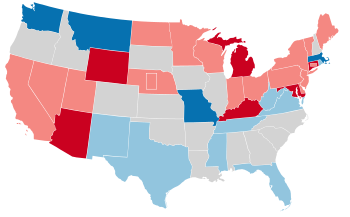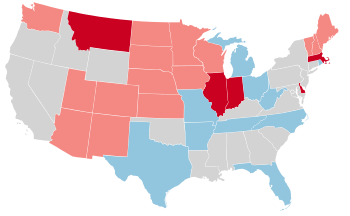
The 1952 United States presidential election was the 42nd quadrennial presidential election and was held on Tuesday, November 4, 1952. Republican Dwight D. Eisenhower won a landslide victory over Democrat Adlai Stevenson II, becoming the first Republican president in 20 years. This was the first election since 1928 without an incumbent president on the ballot.

The 1956 United States presidential election was the 43rd quadrennial presidential election. It was held on Tuesday, November 6, 1956. President Dwight D. Eisenhower successfully ran for reelection against Adlai Stevenson II, the former Illinois governor whom he had defeated four years earlier. This election saw the sixth and most recent rematch in presidential history, and the second where the winner was the same both times. This was the last election before the term limits established by the 22nd Amendment came into effect.

The 82nd United States Congress was a meeting of the legislative branch of the United States federal government, composed of the United States Senate and the United States House of Representatives. It met in Washington, D.C., from January 3, 1951, to January 3, 1953, during the last two years of President Harry S. Truman's second term in office.

The 1952 United States Senate elections was an election for the United States Senate which coincided with the election of Dwight D. Eisenhower to the presidency by a large margin. The 32 Senate seats of Class 1 were contested in regular elections, and three special elections were held to fill vacancies. The Republicans took control of the Senate by managing to make a net gain of two seats. However, Wayne Morse (R-OR) became an independent forcing Republicans to rely on Vice President Richard Nixon's tie-breaking vote, although Republicans maintained a 48-47-1 plurality. Throughout the next Congress, Republicans were able to restore their 49-46-1 majority. This was the third time, as well as second consecutive, in which a sitting Senate leader lost his seat.

The 1956 Democratic National Convention nominated former Governor Adlai Stevenson of Illinois for president and Senator Estes Kefauver of Tennessee for vice president. It was held in the International Amphitheatre on the South Side of Chicago, Illinois August 13–August 17, 1956. Unsuccessful candidates for the presidential nomination included Governor W. Averell Harriman of New York, Senator Lyndon B. Johnson of Texas, and Senator Stuart Symington of Missouri.

The 2008 United States elections were held on Tuesday, November 4, 2008, during the war on terror and the onset of the Great Recession. It was a considered a Democratic wave election, with Democratic Senator Barack Obama of Illinois defeating Senator John McCain of Arizona by a wide margin, and the Democrats bolstering their majorities in both chambers of Congress.

The 1956 United States elections was held on Tuesday, November 6, 1956. Incumbent Republican President Dwight D. Eisenhower won reelection in a landslide, while the Democrats retained control of Congress.

The 1988 United States elections were held on November 8 and elected the President of the United States and members of the 101st United States Congress. Republican Vice President George H. W. Bush defeated Democratic Governor of Massachusetts Michael Dukakis. Despite Dukakis' defeat, the Democratic Party built on their majorities in Congress.
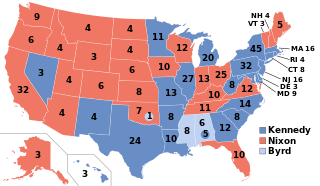
The 1960 United States elections was held on November 8, and elected the members of the 87th United States Congress. Democratic Senator John F. Kennedy narrowly defeated Republican incumbent Vice President Richard Nixon in the presidential election, and although Republicans made gains in both chambers of Congress, the Democratic Party easily maintained control of Congress.

The 1964 United States elections were held in the United States on November 3, 1964, to elect the President of the United States and members of the 89th United States Congress. The elections were held during the Civil Rights Movement and the escalation of the Vietnam War. President Lyndon B. Johnson defeated Senator Barry Goldwater of Arizona in the presidential election, and Johnson's Democratic Party added to their majorities in both chambers of Congress. This was the first presidential election after the ratification of the 23rd Amendment, which granted electoral votes to Washington, D.C.

The 1952 United States presidential election in New York took place on November 4, 1952. All contemporary 48 states were part of the 1952 United States presidential election. Voters chose 45 electors to the Electoral College, which selected the president and vice president.

The 1952 United States presidential election in Massachusetts took place on November 4, 1952, as part of the 1952 United States presidential election, which was held throughout all contemporary 48 states. Voters chose 16 representatives, or electors to the Electoral College, who voted for president and vice president.

The 1952 United States presidential election in New Jersey took place on November 4, 1952. All contemporary 48 states were part of the 1952 United States presidential election. Voters chose 16 electors to the Electoral College, which selected the president and vice president.
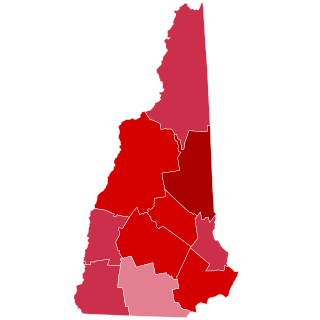
The 1956 United States presidential election in New Hampshire took place on November 6, 1956, as part of the 1956 United States presidential election, which was held throughout all contemporary 48 states. Voters chose four representatives, or electors to the Electoral College, who voted for president and vice president.

The 1952 United States presidential election in New Hampshire took place on November 4, 1952, as part of the 1952 United States presidential election, which was held throughout all contemporary 48 states. Voters chose four representatives, or electors to the Electoral College, who voted for president and vice president.
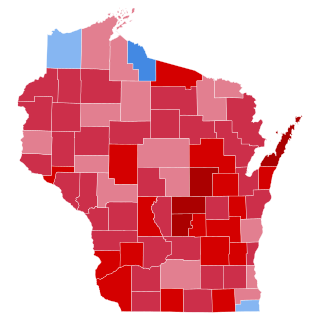
The 1952 United States presidential election in Wisconsin was held on November 4, 1952 as part of the 1952 United States presidential election. State voters chose 12 electors to the Electoral College, who voted for president and vice president.

The 1952 United States presidential election in Minnesota took place on November 4, 1952, as part of the 1952 United States presidential election. Voters chose 11 electors, or representatives to the Electoral College, who voted for president and vice president.

The 1956 United States presidential election in South Carolina took place on November 6, 1956, as part of the 1956 United States presidential election. South Carolina voters chose eight representatives, or electors, to the Electoral College, who voted for president and vice president.

The 1952 United States presidential election in Alabama took place on November 4, 1952, as part of the 1952 United States presidential election. Alabama voters chose eleven representatives, or electors, to the Electoral College, who voted for president and vice president. In Alabama, voters voted for electors individually instead of as a slate, as in the other states.

The 1952 United States presidential election in Wyoming took place on November 4, 1952, as part of the 1952 United States presidential election. State voters chose three representatives, or electors, to the Electoral College, who voted for president and vice president.

